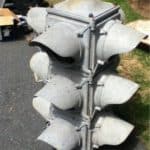How to choose the right light bulbs for your traffic light.
Which light bulbs do I need for my traffic light?
I received an email from George, a visitor to MyTrafficLights.com, looking for information on what kind of light bulbs are needed for the traffic signal he recently picked up. In the real world these days, modern traffic signals are now assembled with LED modules that contain an array of LEDs which will gradually fail over time, usually many, many years, rather than all at once like a regular light bulb. LEDs also use much less electricity, saving towns on their electric bills over time, especially if there are hundreds of signals in a jurisdiction.
But that doesn’t help George. I mean, he could get an LED insert to retrofit his signal. That would involve sourcing an LED insert from ebay or a local contractor, disconnecting and removing the socket, reflector, and lens from the head, then wiring up the new LED after putting it into place. Very cool! But for now, we just want the simple fix: a new bulb.
For a detailed and historical look at the various bulbs that were used in signals over the years, I suggest a look at a page on Willis Lamm’s site where he lists and displays many of the bulbs used in signals throughout history.
Seeing the Light
The simple truth is traffic lights run on 120 volts and all used medium base light bulbs, so you could use just about any regular, incandescent, household bulb you have laying around. I generally use 25 or 40 watt bulbs for indoor displays and up to 60 watts for outdoor displays. Since 8-inch signals usually used 69 watt bulbs and up to 165 watt bulbs for 12-inch-lens signals, there’s really no need to go brighter, especially if your signal and lenses are plastic.
I don’t recommend compact fluorescent bulbs for a couple of reasons.
- One, they are usually REALLY slow to come up to full intensity and likely won’t achieve full brightness in the short time they’re lit.
- They’re not designed for short-duration use like the minute or so that a signal would keep one lit while going through its sequence. They’ll die quickly.
- The design of the bulbs don’t allow for even distribution of light against the reflector, causing shadows and allowing you to easily see the outline of the bulb through the lens.
- They contain mercury, so if one breaks, that’s quite unhealthy for you and the environment.
If energy savings is on your mind, LED bulbs will work well, but don’t quite offer the original look of a clear bulb. The designs of many of these bulbs also suffer from uneven light distribution towards the base of the bulb, casting shadows on the reflector. And be sure to find a bulb that has a color temperature of 3200K or less. With daylight-balanced bulbs, the colors of the lenses will be off, since the glass colors were originally designed with the warmer color temperature of the incandescent bulbs in mind.
This is why I still like to use standard, clear, medium base, incandescent bulbs. They work perfectly well. You may find them as an “appliance bulb”, which are good too. These may offer more durability than just a standard bulb if you move your signal around a lot.







